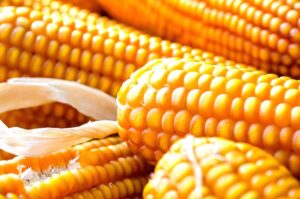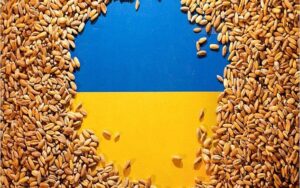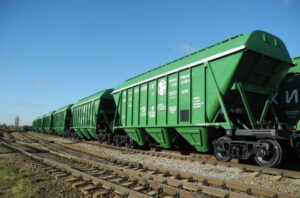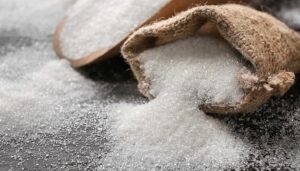
Corn became the most exported commodity in January-February 2025, with a share of 26.5% in agricultural exports and 16% of Ukraine’s total exports, the press service of the State Customs Service (SCS) reported on Telegram.
The agency noted that in January-February 2025, 4.7 million tons of corn were supplied to foreign markets, which amounted to $982 million in monetary terms.
The top five importers of Ukrainian corn are Spain – 933 thsd tonnes, Italy – 725 thsd tonnes, Turkey – 639 thsd tonnes, Egypt – 593 thsd tonnes and the Netherlands – 514 thsd tonnes.

As of March 12, Ukraine exported 31.022 mln tonnes of grains and pulses since the beginning of 2024-2025 marketing year (July-June), of which 1.839 mln tonnes were shipped this month, the press service of the
Ministry of Agrarian Policy and Food reported, citing the data of the State Customs Service of Ukraine.
According to the report, as of March 20 last year, the total shipments amounted to 32.851 mln tons, including 3.181 mln tons in March.
In terms of crops, since the beginning of the current season, Ukraine has exported 12.509 million tons of wheat (526 thousand tons in March), 2.192 million tons of barley (48 thousand tons), 10.8 thousand tons of rye (0), and 15.839 million tons of corn (1.259 million tons).
The total export of Ukrainian flour since the beginning of the season as of March 17 is estimated at 51 thsd tonnes (2.5 thsd tonnes in March), including 47.1 thsd tonnes of wheat (2.4 thsd tonnes).

In February 2025, the Export Credit Agency (ECA) supported UAH 478.6 million of exports by insuring export loans for Ukrainian producers in the amount of UAH 61.3 million and a foreign trade agreement worth UAH 49.4 million.
According to the ECA website, seven exporters used its services, with Oschadbank providing UAH 51.3 million in financing (UAH 298.5 million of supported exports) and Kredobank providing UAH 10 million (UAH 130.65 million of exports).
This time, the leading regions were Zaporizhzhia (UAH 230.4 million of future export revenue), Ternopil (UAH 130.65 million), and Chernihiv (UAH 41.6 million).
These businesses produce and export paper and cardboard, plastics and polymeric materials, land transport vehicles, and various food products to France, Romania, Uzbekistan, India, and Estonia.
The Export Credit Agency was established to stimulate the export of goods (works, services) of Ukrainian origin and support Ukrainian resident exporters by providing insurance, reinsurance, and guarantees under contracts that ensure export development. On January 7, 2023, the National Bank of Ukraine was authorized to regulate the activities of the ECA.

In February 2025, Ukrzaliznytsia (UZ) reduced the volume of grain cargo transportation to export destinations to 2,363.1 thousand tons, which is 496.3 thousand tons, or 17.4% less compared to January 2025, said Valery Tkachev, Deputy Director of the
Commercial Department, at a meeting of the UZ Exporters Office on Wednesday.
According to him, in February 2025, 2,171.0 thousand tons were transported to ports, which is 455.7 thousand tons, or 17.3%, less than in January this year, and 192.1 thousand tons were transported through land border crossings (40.6 thousand tons, or 17.5% less).
“Compared to February 2025/2024, the volume of grain cargo transportation in export traffic decreased by 28.5% (by 941.1 thsd tonnes),” emphasized the representative of UZ.
Mr. Tkachev noted that in January-February 2025, UZ transported 5,222.5 thousand tons of grain cargo for export, which is 1,448.2 thousand tons, or 21.7%, less than in the same period of 2024.
At the same time, 4 797.6 thsd tonnes were transported to ports in two months of 2025, and 424.9 thsd tonnes were transported through land crossings.
Therefore, the share of transportation volumes in the export traffic of grain cargoes in the direction of ports is currently 92%, and 8% by land.

In February 2025, Ukraine increased electricity imports by 33% to 244.2 thousand MWh compared to January and reduced exports by 61% to 33.1 thousand MWh, Ukrainian energy and climate think tank DiXi Group reported citing Energy map.
According to its post on Facebook on Wednesday, the total volume of imports exceeded exports by more than 7 times over the month.
Out of 33.1 thousand MWh of exports, the largest share went to Moldova – 15.5 thousand MWh (47%). Another 10 thousand MWh (30%) went to Hungary, 3.7 thousand MWh (11%) to Romania, 2.9 thousand MWh (9%) to Slovakia, and 1 thousand MWh (3%) to Poland.
DiXi Group experts note that during the last two decades of February, exports were almost non-existent due to a deficit in the power system as a result of massive Russian missile and drone strikes (February 1, 11 and 20), as well as a drop in air temperature.
On the contrary, imports in February, according to their data, increased, reaching 244.2 thousand MWh against 183.1 thousand MWh in January. Of this amount, 85.2 thousand MWh (35%) came from Hungary, 73.3 thousand MWh (30%) – from Slovakia, 46.3 thousand MWh (19%) – from Poland, 37.1 thousand MWh (15%) – from Romania, 2.3 thousand MWh (1%) – from Moldova.
The increase in imports was recorded in all available directions (from 34% to 80%), except for Poland, from which it decreased by 23%.
DiXi Group notes that compared to February 2024, when 84.1 thousand MWh were imported, imports have almost tripled.

From September to February (6 months of the 2024-2025 marketing year), Ukraine exported more than 403.5 thousand tons of sugar, of which 1.6% was sent to the EU countries, the rest to world markets, the press service of the National Association of Sugar Producers of Ukraine “Ukrtsukor” reported.
The industry association noted that exports to the EU resumed in February and amounted to 6,559 tons. The main EU countries where Ukrainian sugar was exported were Bulgaria (72% of the exported volume), Greece (12%) and Italy (12%).
The main export destinations for Ukrainian sugar in the first 6 months of 2024/25 MY were Turkey (18% of total exports), Libya, North Macedonia, Somalia, and Sri Lanka.
As reported, in the production season of 2024, Ukrainian sugar producers produced 1.8 million tons of sugar. The volume of the domestic market in Ukraine is currently estimated at 900 thousand tons per year.